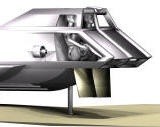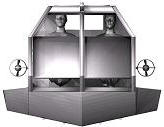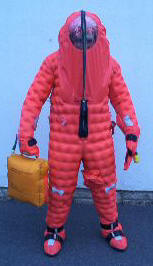EscapeFor some reason the question: "How do you Escape in an emergency?" comes up quickly in most conversation. I suppose we all have images for War War II submarine movies in the back of our minds.
Enable submariners to escape? Perhaps "enable" is too strong of a word. From 600 feet I think "give them a chance" is more accurate. As I understand it you first get your ears vented with a needle by the ships doctor in order to prevent them from bursting. Ouch! Then you suite up, and enter the escape chamber. At this point your body is still protected from the pressure of the surrounding water by the submarine's hull. Now the chamber's door from the sub is closed and the chamber floods with outside water, very quickly pressurizing the air in the chamber, under the hood and also inside your lungs. Your body goes from 15 psi to 280 psi. If you did not pass out, you are now in freezing water and breathing 280 psi compressed air trapped under the hood. Next the outside hatch opens and you become a human air bubble rocketing toward the surface. As you ascend the air that was compressed into your lungs and under your hood starts to expand. The increased air volume under the hood only makes you a bigger bubble and so your speed increases. It is very important that during the accent you constantly breath out. Remember the air is expanding, so that lung full of air at 600 feet will become 19 lungs of air on the way up. This rate of expansion is according to Boyles Law which states that air compresses proportionately to the amount of pressure applied. So when your coming up, the pressure is being reduced and the air is expanding. The graph below shows how that 1 lung full of air expands as you ascend from 19 atmospheres to the surface.
Now, breathing out while underwater is not a natural thing to do, but if you don't your lungs will expand and burst, and you will drown in your own blood. All of the air escaping from your lungs and expanding inside the hood will soon over fill the hood and escape from the openings around your chest or through a purge valve. Once your on the surface, if you're still alive you only have to deal with the mess you made in your pants. All this also assumes that your submarine was still at 1 ATM. If your submarine was taking on water then the air remaining in the sub was already being compressed and your body was absorbing nitrogen, just like a scuba diver. If you have too much nitrogen then your going suffer from the bends because your rapid accent did not provide enough time for your body to discard the excess nitrogen. Suffering from the bends or being "bent" results in pain in your joints, paralysis, or death. If your alive on the surface and suffering from the bends then your only hope to to immediately be placed in a chamber that can be pressurized in order to allow a controlled and slow release of the nitrogen. Hopefully the survival kit is still tethered to your suite and the transponder works, and someone friendly can find you bobbing in somewhere in the ocean.
|


 Form
an ambient sub escape is not a difficult thing. You just need to be
able to open a hatch and ascend slowly to the surface while
breathing from a spare air bottle. Regular dive weights or an
accent line are used to slow your accent. You will also never be
below 120 feet so the surface is not that far away. Escape from a 1
ATM sub is more complex, and often not even possible. 1 ATM or 1
atmosphere subs are frequently much deeper. They can go deeper
because the pressure inside the sub does not change after they close
their hatch when leaving the surface. As they go deeper the
pressure inside the sub remains the same and instead the pressure on
the hull increases. When they go too deep the hull implodes which
will most likely kill all of the occupants instantly. If the
problem is less sever then they might have a chance for survival by
using an escape suit like the Mk9 in the photo. This suite was
developed to enable submariners to escape from a stricken sub from
depths of up to 182mtrs or 600feet, and doubles as a great Halloween
costume.
Form
an ambient sub escape is not a difficult thing. You just need to be
able to open a hatch and ascend slowly to the surface while
breathing from a spare air bottle. Regular dive weights or an
accent line are used to slow your accent. You will also never be
below 120 feet so the surface is not that far away. Escape from a 1
ATM sub is more complex, and often not even possible. 1 ATM or 1
atmosphere subs are frequently much deeper. They can go deeper
because the pressure inside the sub does not change after they close
their hatch when leaving the surface. As they go deeper the
pressure inside the sub remains the same and instead the pressure on
the hull increases. When they go too deep the hull implodes which
will most likely kill all of the occupants instantly. If the
problem is less sever then they might have a chance for survival by
using an escape suit like the Mk9 in the photo. This suite was
developed to enable submariners to escape from a stricken sub from
depths of up to 182mtrs or 600feet, and doubles as a great Halloween
costume. 